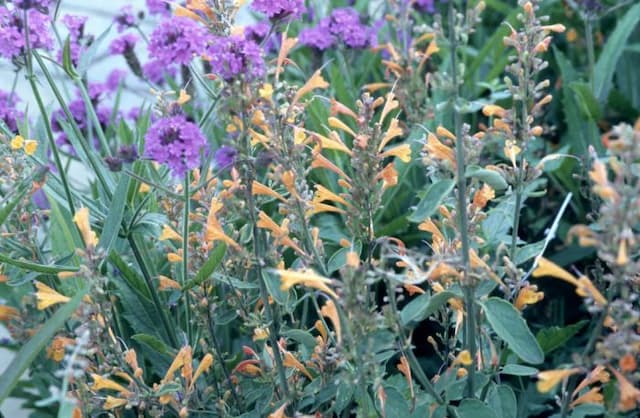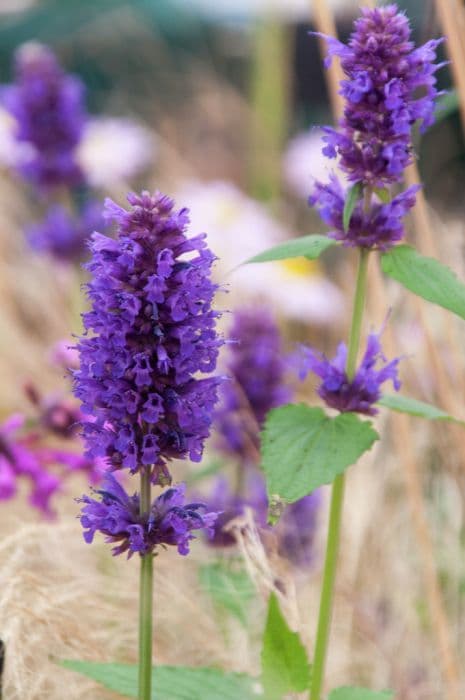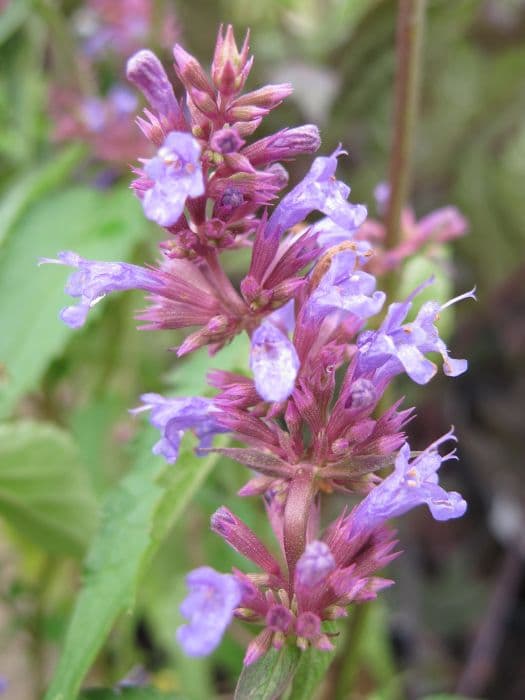Foxley Thyme Thymus pulegioides 'Foxley' (v)

ABOUT
Thymus pulegioides 'Foxley' (v), commonly known as Foxley thyme, is a low-growing, aromatic evergreen perennial herb that's often used in gardens for its attractive foliage and flowers. Its leaves are small, oval-shaped, and variegated, combining green with creamy white edges, which can sometimes have a hint of pink, especially in cooler temperatures. The leaves are soft to the touch, with a texture that can be described as slightly fuzzy or plush. During the blooming season, Foxley thyme produces clusters of tubular, lilac to pink flowers that emerge above the foliage. These flowers are tiny and arranged in little whorls that provide a colorful contrast against the variegated leaves. The plant has a tendency to spread, forming a dense mat that can create a lovely ground cover or edge detail in a garden setting. Its overall appearance is one of an ornamental and practical herb, appreciated both for its culinary uses and its decorative qualities.
About this plant
 Names
NamesFamily
Lamiaceae.
Synonyms
Large Thyme, Lemon Thyme, Archer's Gold Thyme, Foxley Thyme.
Common names
Thymus pulegioides 'Foxley'.
 Characteristics
CharacteristicsLife cycle
Perennials
Foliage type
Evergreen
Color of leaves
Variegated
Flower color
Pink
Height
6 inches (15 cm)
Spread
18 inches (45 cm)
Plant type
Herb
Hardiness zones
5
Native area
Europe
Benefits
 General Benefits
General Benefits- Culinary Uses: 'Foxley' thyme is used to flavor a variety of dishes, including meats, soups, and sauces.
- Attracts Pollinators: It is known for attracting bees and butterflies, which are beneficial for pollinating gardens.
- Aesthetic Appeal: This variety has variegated foliage that adds visual interest to gardens and landscapes.
- Herbal Tea: Leaves can be used to make a herbal tea that is enjoyed for its taste.
- Ground Cover: It can serve as an effective ground cover, reducing soil erosion and suppressing weeds.
- Drought Tolerance: Once established, it is drought-resistant, making it suitable for water-wise gardens.
- Fragrance: The plant emits a pleasant fragrance, which can enhance the sensory appeal of a garden or patio.
- Low Maintenance: Requires minimal care once established, making it a good choice for novice gardeners.
- Culinary Decoration: The variegated leaves can be used as a decorative garnish for dishes.
- Habitat Creation: Offers shelter and food to a range of garden wildlife, contributing to biodiversity.
 Medical Properties
Medical Properties- Antimicrobial: Contains thymol, which is known for its antibacterial and antifungal properties.
- Antispasmodic: May help to relieve spasms of the muscles.
- Expectorant: Can assist in the removal of mucus from the airways, possibly aiding in respiratory conditions.
- Carminative: Might help in reducing gas in the gastrointestinal tract.
- Antioxidant: Potential to prevent damage caused by free radicals, due to the presence of flavonoids and phenolic compounds.
- Antitussive: May help in suppressing coughs.
 Air-purifying Qualities
Air-purifying QualitiesThis plant is not specifically known for air purifying qualities.
 Other Uses
Other Uses- Thymus pulegioides 'Foxley' can serve as a ground cover in gardens, spreading to create a dense mat of foliage that suppresses weeds and withstands light foot traffic.
- Its colorful variegated leaves can be used to add visual interest and contrast in rock gardens or along pathways, where its low-growing habit and toughness are appreciated.
- The plant is suited for container gardening, where its aromatic foliage and flowers can be enjoyed up close on patios or balconies.
- It can be used in culinary applications, where the leaves are added to flavor meat dishes, sauces, soups, and marinades.
- The leaves can be dried and used in potpourri mixtures, imparting their pleasant fragrance to indoor environments.
- As a companion plant in vegetable gardens, it may help deter certain pests with its strong scent, potentially benefiting plants like tomatoes.
- It serves as a valuable plant for pollinators, attracting bees and butterflies which are key to a healthy and productive garden ecosystem.
- It can be used as a natural dye source, where the leaves produce subtle colors when used in the dying of fabrics or yarns.
- The fresh or dried leaves can be incorporated into homemade herbal wreaths or arrangements, offering both visual and aromatic qualities.
- The flowers can be used as a garnish for salads, desserts, and drinks, not only enhancing the look but also giving a slight herbal flavor.
Interesting Facts
 Feng Shui
Feng ShuiThe plant Thyme is not used in Feng Shui practice.
 Zodiac Sign Compitability
Zodiac Sign CompitabilityThe plant Thyme is not used in astrology practice.
 Plant Symbolism
Plant Symbolism- Courage: Thyme, including Thymus pulegioides 'Foxley', is often associated with bravery and boldness. In the past, knights would carry sprigs of thyme as a sign of their courage.
- Strength: Thyme is believed to symbolize strength, perhaps due to its robust nature and persistent growth, symbolizing the human capacity to thrive in challenging conditions.
- Healing: Thyme has a longstanding association with medicinal properties, often symbolizing health and healing, hinting at its use in traditional remedies.
- Protection: Thyme is also thought to offer protection. It was used in ancient practices for warding off negativity or to bring good sleep by placing it beneath pillows.
- Cleansing: The plant's antiseptic qualities have led to its symbolism for purification, suggesting its power to cleanse both physically and spiritually.
- Passion: Some traditions hold thyme as a symbol of passion, with its potent fragrance and flavor being seen as an embodiment of intense emotion.
 Water
WaterLemon thyme (Thymus pulegioides 'Foxley') prefers to be watered when the top inch of soil feels dry to the touch. This usually means watering approximately once a week, but this can vary based on temperature and humidity conditions. When watering, it's best to use a watering can or hose with a gentle spray setting to evenly moisten the soil without eroding it. Give the plant about a gallon of water per session, ensuring that the water penetrates deeply to reach the roots but does not leave the plant sitting in waterlogged soil. Always check the soil moisture level before watering to prevent overwatering.
 Light
LightLemon thyme thrives in full sun to partial shade. The best spot for this plant is in an area where it will receive at least six hours of direct sunlight each day. If you're growing lemon thyme indoors, a south-facing window is ideal to provide sufficient light.
 Temperature
TemperatureLemon thyme can survive in temperatures as low as 20 degrees Fahrenheit and as high as 80 degrees Fahrenheit. The ideal temperature conditions for this plant are between 60 and 70 degrees Fahrenheit. Lemon thyme is quite hardy and can tolerate a wide range of temperatures, but it will perform best within this range.
 Pruning
PruningLemon thyme should be pruned to encourage a bushier growth habit and to prevent woody stems. Pruning can be done in the early spring or after the plant has flowered. Cut back about one-third of the growth to shape the plant and remove any dead or woody stems. Pruning this way once a year is typically sufficient.
 Cleaning
CleaningAs needed
 Soil
SoilLemon thyme 'Foxley' thrives best in well-draining soil with a pH ranging from 6.0 to 8.0. A mix of two parts potting soil, one part perlite, and one part coarse sand is ideal to ensure proper drainage. Organic matter such as compost can be added to enrich the soil, but it is essential to avoid heavy, water-retentive soils that could lead to root rot.
 Repotting
RepottingLemon thyme 'Foxley' does not require frequent repotting and can typically be repotted every 2-3 years or when the plant has outgrown its current container. It's a relatively low-maintenance herb and prefers to be in a snug pot that's just slightly larger than the root ball.
 Humidity & Misting
Humidity & MistingLemon thyme 'Foxley' is tolerant of a wide range of humidity levels but prefers a drier environment. It does not require high humidity and will flourish in the average humidity levels found in most homes and gardens.
 Suitable locations
Suitable locationsIndoor
Provide lemon thyme with bright light and good airflow.
Outdoor
Plant in full sun, ensure soil drains well, and space adequately.
Hardiness zone
5-9 USDA.
 Life cycle
Life cycleThymus pulegioides 'Foxley', commonly known as the variegated large thyme, begins its life as a seed which germinates in spring when soil temperatures warm. As a seedling, it first develops a rosette of leaves at the soil surface before establishing a deeper root system. Following the vegetative stage, the plant matures and starts producing characteristic aromatic leaves and stems, which are variegated in this cultivar. In late spring to early summer, it enters the reproductive phase with the blooming of small, attractive flowers that attract pollinators and are typically lavender to pink in color. After pollination, the flowers produce seeds that complete the plant's reproductive cycle. The variegated large thyme is a perennial herb, so it dies back in the winter and re-emerges from its rootstock in the spring, continuing its life cycle for several years.
 Propogation
PropogationPropogation time
Spring to early summer
Thymus pulegioides 'Foxley', commonly known as creeping thyme, typically is propagated by cuttings or division, and the most popular method is by cuttings. This is usually done in late spring or early summer when the plant is actively growing. For propagation by cuttings, select a healthy, non-flowering stem and cut a 2 to 4-inch (5 to 10 cm) section just below a node. Remove the leaves from the lower half of the cutting, and dip the cut end into a rooting hormone. Plant the cutting in a well-draining soil mix and keep it moist but not waterlogged. Place the pot in a warm place with indirect light, and roots will generally begin to form within 2 to 6 weeks. Once the cuttings have established a strong root system, they can be transplanted to their final location.







![Bugle [Black Scallop]](/_next/image?url=https%3A%2F%2Fplants-admin.emdemapps.com%2Fimages%2Fplants%2F%2Fimages%2F604b624330cd1.png&w=640&q=75)

